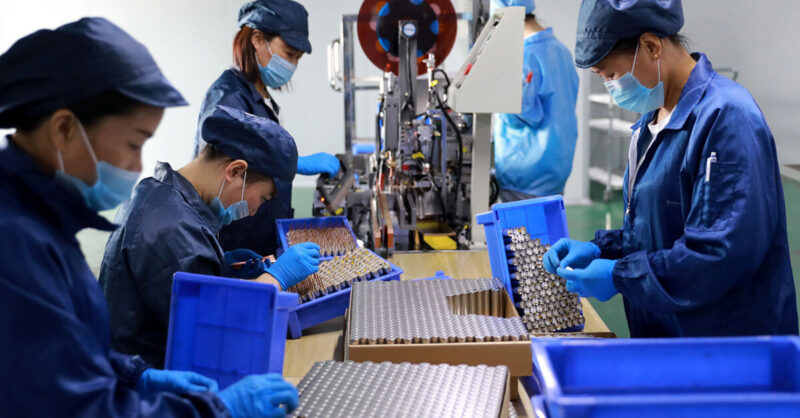Flaw detector standby power design scheme
The flaw detector is a portable industrial non-destructive flaw detection instrument, which can quickly, conveniently, non-destructively and accurately detect, locate, evaluate and diagnose various defects (welds, cracks, inclusions, folds, pores, sand holes, etc.) inside the workpiece , can be used both in the laboratory and on the engineering site. The instrument can be widely used in manufacturing, iron and steel metallurgy, metal processing, chemical industry and other fields that require defect detection and quality control. Life assessment, which is a must for the non-destructive testing industry. Portable flaw detectors have become an important tool for on-site testing in modern society, and providing efficient, portable, light, and sufficient backup power solutions for portable flaw detectors is an important guarantee for testers to carry out long-term on-site work. Because of its own unique advantages, 18650 lithium battery pack has become the first choice for the backup power solution of such high-tech testing instruments.
1. Design requirements for spare lithium battery of flaw detector
Due to the high voltage and long working hours of the flaw detector, the quality of the equipment itself and the continuous stability of the power supply are particularly critical, which requires that the power supply must be realized by a multi-series parallel combination of large-capacity single lithium batteries; in the flaw detector During the working process, a large amount of valuable data needs to be saved continuously, so it is necessary to provide an accurate battery power display and an alarm system to prompt the user to save the data in time to improve the effectiveness of the work. The backup lithium battery solution of this flaw detector adopts an intelligent chip, and the host continuously reads the power and related important data in the intelligent chip through I2C communication, and monitors the battery constantly to prompt the user to perform relevant operations in a reasonable and timely manner. The Sanyo batteries integrated in our solution have the advantages of high energy ratio, light weight, small size, high cycle life, high safety, high voltage, and good consistency. The lithium battery pack is designed to output an overcurrent protection value of 12A, and the continuous working current 7A, charging capacity 5000mAh, fully meet the power demand of the instrument. The specific design requirements parameters are as follows:
1) Lithium battery pack model design requirements: 18650-3S2P/5000mAh/11.1V.
2) Circuit part design requirements:
1. Single cell overcharge protection voltage: 4.35±0.25V
2. Single cell overcharge recovery voltage: 4.15±0.50V
3. Single-cell over-discharge protection voltage: 2.40±0.08V
4. Single-cell over-discharge recovery voltage: 3.00±0.10V
5. Combined battery overcurrent protection value (10ms): 30~35A
6. Combined battery over-temperature protection value (recoverable): 70±5°C
7. The finished battery also has short-circuit and reverse charge protection.
3) Design requirements for battery cycle life: 300~500 times (national standard charge and discharge standard)
4) Design requirements for battery dimensions: refer to the battery case
2. Design scheme of spare lithium battery for flaw detector
1) Intelligent power gauge protection board (PCM): adopts SBS intelligent battery management system, uses advanced power calculation principles to accurately calculate the battery power at all times, and reports the battery power information to the host through SMBUS at all times, and at the same time reports to the rechargeable smart battery Due to the chemical characteristics of the lithium battery itself, it is necessary to provide protection functions such as overcharge, overdischarge, short circuit, overcurrent and overtemperature to avoid dangers such as combustion and explosion.
2) 18650 Li-ion battery/18650/2500mAh/3.7V Li-ion cell (SANYO).
3) Temperature switch: mainly designed for temperature protection function. When the temperature of the battery itself reaches the range of 70±5°C due to other abnormal problems, the temperature switch acts to perform temperature protection.
4) Field effect tube (MOSFET): MOSFET tube, which acts as a switch in the protection circuit, will always keep the voltage at both ends of the load from rising or falling, ensuring voltage stability.
5) Battery pack packaging (housing)
-
 As the world becomes increasingly reliant on renewable energy sources, the need for high-performance energy storage solutions has never been more pressing. One such solution is the 12V 100Ah LiFePO4 battery, which offers a range of benefits over traditional lead-acid batteries. Firstly, LiFePO4 batteries have a much longer lifespan than lead-acid batteries. While lead-acid batteries typically last for around...En savoir plus
As the world becomes increasingly reliant on renewable energy sources, the need for high-performance energy storage solutions has never been more pressing. One such solution is the 12V 100Ah LiFePO4 battery, which offers a range of benefits over traditional lead-acid batteries. Firstly, LiFePO4 batteries have a much longer lifespan than lead-acid batteries. While lead-acid batteries typically last for around...En savoir plus -
 In recent years, the demand for more efficient and sustainable energy storage solutions has grown exponentially. With the rise of renewable energy sources such as solar and wind power, there is a pressing need for batteries that can store and release energy efficiently. The lithium-ion battery has emerged as a key player in this arena, revolutionizing energy storage and paving...En savoir plus
In recent years, the demand for more efficient and sustainable energy storage solutions has grown exponentially. With the rise of renewable energy sources such as solar and wind power, there is a pressing need for batteries that can store and release energy efficiently. The lithium-ion battery has emerged as a key player in this arena, revolutionizing energy storage and paving...En savoir plus -
 IntroductionThe locomotive starter battery is an essential component of today\'s railway system. It is responsible for providing the initial power to start the locomotive engine, which then powers the train. The battery also provides backup power in case of a power failure or emergency. In this article, we will discuss the role of the locomotive starter battery in powering up...En savoir plus
IntroductionThe locomotive starter battery is an essential component of today\'s railway system. It is responsible for providing the initial power to start the locomotive engine, which then powers the train. The battery also provides backup power in case of a power failure or emergency. In this article, we will discuss the role of the locomotive starter battery in powering up...En savoir plus -
 Introduction: The battery industry has experienced significant advancements in technology and sustainability in recent years. These breakthroughs have revolutionized various sectors, including consumer electronics, electric vehicles, and renewable energy. This article will explore the latest developments in battery technology and the efforts towards creating more sustainable and eco-friendly batteries. 1. Lithium-ion Batteries: Lithium-ion batteries have become the dominant technology...En savoir plus
Introduction: The battery industry has experienced significant advancements in technology and sustainability in recent years. These breakthroughs have revolutionized various sectors, including consumer electronics, electric vehicles, and renewable energy. This article will explore the latest developments in battery technology and the efforts towards creating more sustainable and eco-friendly batteries. 1. Lithium-ion Batteries: Lithium-ion batteries have become the dominant technology...En savoir plus -
 With the increasing popularity of electric vehicles (EVs), the importance of efficient and reliable batteries has become paramount. Among the various types of batteries available, lithium batteries have emerged as the preferred choice for powering EVs. This article will discuss the advantages of using lithium batteries in electric vehicles. First and foremost, lithium batteries offer a significantly higher energy...En savoir plus
With the increasing popularity of electric vehicles (EVs), the importance of efficient and reliable batteries has become paramount. Among the various types of batteries available, lithium batteries have emerged as the preferred choice for powering EVs. This article will discuss the advantages of using lithium batteries in electric vehicles. First and foremost, lithium batteries offer a significantly higher energy...En savoir plus -
 In today's world, we are heavily reliant on portable electronic devices such as smartphones, laptops, and tablets. With the increasing need for uninterrupted power supply, people are turning to advanced battery technologies like Lithium Iron Phosphate (LiFePO4) batteries. One such battery that has gained popularity is the 12V 200Ah LiFePO4 battery. In this article, we will explore why this battery...En savoir plus
In today's world, we are heavily reliant on portable electronic devices such as smartphones, laptops, and tablets. With the increasing need for uninterrupted power supply, people are turning to advanced battery technologies like Lithium Iron Phosphate (LiFePO4) batteries. One such battery that has gained popularity is the 12V 200Ah LiFePO4 battery. In this article, we will explore why this battery...En savoir plus -
 The High Capacity 12V 100Ah LiFePO4 Battery is the perfect solution for those looking for long-lasting power solutions. This battery is designed to provide reliable and consistent power to a wide range of applications, from electric vehicles to solar energy storage systems. One of the key benefits of this battery is its high capacity. With a capacity of 100Ah,...En savoir plus
The High Capacity 12V 100Ah LiFePO4 Battery is the perfect solution for those looking for long-lasting power solutions. This battery is designed to provide reliable and consistent power to a wide range of applications, from electric vehicles to solar energy storage systems. One of the key benefits of this battery is its high capacity. With a capacity of 100Ah,...En savoir plus

